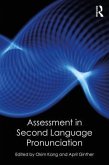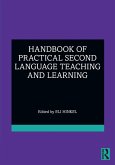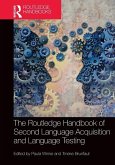The Routledge Handbook of Contemporary English Pronunciation
Herausgegeben:Kang, Okim; Thomson, Ron I.; Murphy, John M
The Routledge Handbook of Contemporary English Pronunciation
Herausgegeben:Kang, Okim; Thomson, Ron I.; Murphy, John M
- Broschiertes Buch
- Merkliste
- Auf die Merkliste
- Bewerten Bewerten
- Teilen
- Produkt teilen
- Produkterinnerung
- Produkterinnerung
The Routledge Handbook of Contemporary English Pronunciation provides a comprehensive survey of this field covering both theoretical and practical perspectives on pronunciation. In 35 chapters contributed by leading scholars from around the world, this Handbook examines:
linguistic and historical background of sound systems and theoretical issues linked to sound changes;
pronunciation acquisition and factors related to speech production;
pronunciation research and applications to second language pronunciation;
the link between pronunciation and other language skills including…mehr
Andere Kunden interessierten sich auch für
![Assessment in Second Language Pronunciation Assessment in Second Language Pronunciation]() Assessment in Second Language Pronunciation39,99 €
Assessment in Second Language Pronunciation39,99 €![The Routledge Handbook of English as a Lingua Franca The Routledge Handbook of English as a Lingua Franca]() The Routledge Handbook of English as a Lingua Franca48,99 €
The Routledge Handbook of English as a Lingua Franca48,99 €![Introduction to Instructed Second Language Acquisition Introduction to Instructed Second Language Acquisition]() Shawn LoewenIntroduction to Instructed Second Language Acquisition38,99 €
Shawn LoewenIntroduction to Instructed Second Language Acquisition38,99 €![The Routledge Handbook of Second Language Acquisition and Speaking The Routledge Handbook of Second Language Acquisition and Speaking]() The Routledge Handbook of Second Language Acquisition and Speaking232,99 €
The Routledge Handbook of Second Language Acquisition and Speaking232,99 €![Handbook of Practical Second Language Teaching and Learning Handbook of Practical Second Language Teaching and Learning]() Handbook of Practical Second Language Teaching and Learning138,99 €
Handbook of Practical Second Language Teaching and Learning138,99 €![The Routledge Handbook of Second Language Acquisition and Language Testing The Routledge Handbook of Second Language Acquisition and Language Testing]() The Routledge Handbook of Second Language Acquisition and Language Testing49,99 €
The Routledge Handbook of Second Language Acquisition and Language Testing49,99 €![English Pronunciation Models in a Globalized World English Pronunciation Models in a Globalized World]() Andrew Sewell (Hong Kong Lingnan University)English Pronunciation Models in a Globalized World64,99 €
Andrew Sewell (Hong Kong Lingnan University)English Pronunciation Models in a Globalized World64,99 €-
-
-
The Routledge Handbook of Contemporary English Pronunciation provides a comprehensive survey of this field covering both theoretical and practical perspectives on pronunciation. In 35 chapters contributed by leading scholars from around the world, this Handbook examines:
linguistic and historical background of sound systems and theoretical issues linked to sound changes;
pronunciation acquisition and factors related to speech production;
pronunciation research and applications to second language pronunciation;
the link between pronunciation and other language skills including perception and other socio-cultural factors;
pronunciation and its relation to World Englishes.
The Routledge Handbook of Contemporary English Pronunciation will be essential reading for anyone with an interest in pronunciation.
linguistic and historical background of sound systems and theoretical issues linked to sound changes;
pronunciation acquisition and factors related to speech production;
pronunciation research and applications to second language pronunciation;
the link between pronunciation and other language skills including perception and other socio-cultural factors;
pronunciation and its relation to World Englishes.
The Routledge Handbook of Contemporary English Pronunciation will be essential reading for anyone with an interest in pronunciation.
Produktdetails
- Produktdetails
- Routledge Handbooks in English Language Studies
- Verlag: Routledge / Taylor & Francis
- Seitenzahl: 618
- Erscheinungstermin: 30. Juni 2021
- Englisch
- Abmessung: 246mm x 174mm x 33mm
- Gewicht: 1140g
- ISBN-13: 9781032096148
- ISBN-10: 1032096144
- Artikelnr.: 62150099
- Herstellerkennzeichnung
- Libri GmbH
- Europaallee 1
- 36244 Bad Hersfeld
- gpsr@libri.de
- Routledge Handbooks in English Language Studies
- Verlag: Routledge / Taylor & Francis
- Seitenzahl: 618
- Erscheinungstermin: 30. Juni 2021
- Englisch
- Abmessung: 246mm x 174mm x 33mm
- Gewicht: 1140g
- ISBN-13: 9781032096148
- ISBN-10: 1032096144
- Artikelnr.: 62150099
- Herstellerkennzeichnung
- Libri GmbH
- Europaallee 1
- 36244 Bad Hersfeld
- gpsr@libri.de
Okim Kang is Associate Professor at Northern Arizona University, USA. Ron Thomson is Professor at Brock University, Canada. John M. Murphy is Professor at Georgia State University, USA.
Introduction Okim Kang, Ron I. Thomson and John M. Murphy Section 1: Historical and theoretical perspectives on pronunciation Chapter 1 Transfer, contrastive analysis and interlanguage phonology John Archibald Chapter 2 Theoretical L2 phonology Fred R. Eckman Chapter 3 An overview of phonetics for language teachers Joanna Przedlacka Chapter 4 Phonological development in first languages Lillian May, Tania S. Zamuner and Janet F. Werker Chapter 5 Second language pronunciation learning: an overview of theoretical perspectives Jennifer A. Foote and Pavel Trofimovich Section 2: Descriptions of English pronunciations Chapter 6 English vowels and consonants Pamela Rogerson-Revell Chapter 7 English syllable structure Walcir Cardoso Chapter 8 English lexical stress, prominence and rhythm Jane Setter and Boikanyego Sebina Chapter 9 Intonation and language learning Ann Wennerstrom Chapter 10 English orthography as a resource for learners of English Wayne B. Dickerson Section 3: Varieties of English pronunciations Chapter 11 Standards of pronunciation and regional accents Kirk Hazen Chapter 12 The fallacy of standard English Nur Raihan and David Deterding Chapter 13 New Pronunciation en route to world Englishes David Deterding and Ishamina Athirah Gardiner Chapter 14 Instructional models in the global context Jolanta Szpyra-Kozlowska Section 4 : Pronunciation instruction in language teaching Chapter 15 Pronunciation teaching in the pre-CLT era Amanda A. Baker Chapter 16 Pronunciation teaching in the early CLT Era John Levis and Sinem Sonsaat Chapter 17 Ethics and the business of pronunciation instruction Jennifer A. Foote Chapter 18 Teacher training in the teaching of pronunciation John M. Murphy Chapter 19 The efficacy of pronunciation instruction Tracey M. Derwing Section 5: Current issues in pronunciation research Chapter 20 Pronunciation and speaking Jonathan Newton Chapter 21 Pronunciation and listening: the case for separation Richard Cauldwell Chapter 22 Pronunciation with other areas of language Tamara Jones Chapter 23 Pronunciation and individual differences Jette G. Hansen Edwards Chapter 24 Attitudes toward non-native pronunciation Stephanie Lindemann and Maxi-Ann Campbell Chapter 25 Dimensions of pronunciation Murray J. Munro Chapter 26 Pronunciation in discourse contexts Lucy Pickering Section 6: Future directions of pronunciation Chapter 27 Innovations in pronunciation teaching Donna M. Brinton Chapter 28 Applying a cognitive linguistic framework to L2 pronunciation teaching Graeme Couper Chapter 29 Computer-assisted pronunciation teaching Debra M. Hardison Chapter 30 Pronunciation future in twenty-first century English-speaking world: context, choice and consultation Ivor Timmis Chapter 31 Assessment in second language pronunciation Okim Kang and Alyssa Kermad Chapter 32 Sugrasegmental aspects of pronunciation in New Englishes Ee Ling Low Chapter 33 Intelligibility in global contexts Jagdish Kaur Chapter 34 Automatic speech recognition for second language pronunciation training Catia Cucchiarini and Helmer Strik Chapter 35 Fully automated speaking assessments: changes to proficiency testing and the role of pronunciation Talia Isaacs
Introduction Okim Kang, Ron I. Thomson and John M. Murphy Section 1: Historical and theoretical perspectives on pronunciation Chapter 1 Transfer, contrastive analysis and interlanguage phonology John Archibald Chapter 2 Theoretical L2 phonology Fred R. Eckman Chapter 3 An overview of phonetics for language teachers Joanna Przedlacka Chapter 4 Phonological development in first languages Lillian May, Tania S. Zamuner and Janet F. Werker Chapter 5 Second language pronunciation learning: an overview of theoretical perspectives Jennifer A. Foote and Pavel Trofimovich Section 2: Descriptions of English pronunciations Chapter 6 English vowels and consonants Pamela Rogerson-Revell Chapter 7 English syllable structure Walcir Cardoso Chapter 8 English lexical stress, prominence and rhythm Jane Setter and Boikanyego Sebina Chapter 9 Intonation and language learning Ann Wennerstrom Chapter 10 English orthography as a resource for learners of English Wayne B. Dickerson Section 3: Varieties of English pronunciations Chapter 11 Standards of pronunciation and regional accents Kirk Hazen Chapter 12 The fallacy of standard English Nur Raihan and David Deterding Chapter 13 New Pronunciation en route to world Englishes David Deterding and Ishamina Athirah Gardiner Chapter 14 Instructional models in the global context Jolanta Szpyra-Kozlowska Section 4 : Pronunciation instruction in language teaching Chapter 15 Pronunciation teaching in the pre-CLT era Amanda A. Baker Chapter 16 Pronunciation teaching in the early CLT Era John Levis and Sinem Sonsaat Chapter 17 Ethics and the business of pronunciation instruction Jennifer A. Foote Chapter 18 Teacher training in the teaching of pronunciation John M. Murphy Chapter 19 The efficacy of pronunciation instruction Tracey M. Derwing Section 5: Current issues in pronunciation research Chapter 20 Pronunciation and speaking Jonathan Newton Chapter 21 Pronunciation and listening: the case for separation Richard Cauldwell Chapter 22 Pronunciation with other areas of language Tamara Jones Chapter 23 Pronunciation and individual differences Jette G. Hansen Edwards Chapter 24 Attitudes toward non-native pronunciation Stephanie Lindemann and Maxi-Ann Campbell Chapter 25 Dimensions of pronunciation Murray J. Munro Chapter 26 Pronunciation in discourse contexts Lucy Pickering Section 6: Future directions of pronunciation Chapter 27 Innovations in pronunciation teaching Donna M. Brinton Chapter 28 Applying a cognitive linguistic framework to L2 pronunciation teaching Graeme Couper Chapter 29 Computer-assisted pronunciation teaching Debra M. Hardison Chapter 30 Pronunciation future in twenty-first century English-speaking world: context, choice and consultation Ivor Timmis Chapter 31 Assessment in second language pronunciation Okim Kang and Alyssa Kermad Chapter 32 Sugrasegmental aspects of pronunciation in New Englishes Ee Ling Low Chapter 33 Intelligibility in global contexts Jagdish Kaur Chapter 34 Automatic speech recognition for second language pronunciation training Catia Cucchiarini and Helmer Strik Chapter 35 Fully automated speaking assessments: changes to proficiency testing and the role of pronunciation Talia Isaacs








